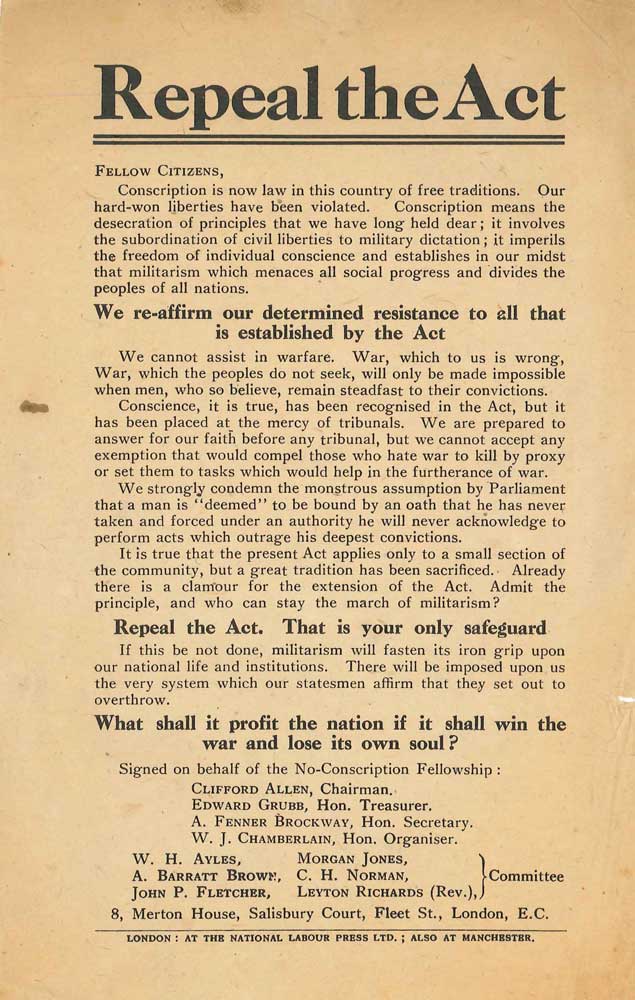
Objects from our Archives: “Repeal the Act” from the No Conscription Fellowship. Written and Printed in London, Salisbury Court, Fleet Street and Manchester. The location of the printing presses for leaflets such as these is often a mystery - police pressure caused the No-Conscription Fellowship (NCF) to move presses whenever possible, and underground smuggling of leaflets became common towards the end of the war. This leaflet, published before any major effort to shut down the NCF was printed by the sympathetic National Labour Press. It was printed on cheap paper to make sure it could be printed by the thousands for the NCF, which always operated on a shoestring budget. WHY IS IT IMPORTANT? “Repeal the Act” is one of a series of leaflets published by the No Conscription Fellowship opposing the Military Service Act that imposed conscription on Britain. It calls for an end to conscription as a violation of civil liberties and establishes the reasons behind conscientious objection. While the NCF had been active from 1914 onwards, Repeal the Act is one of the first leaflets to be seen country-wide. Some sources estimate around 750,000 copies were distributed. This makes it crucial to the story of conscientious objection as it acted as a rallying cry for groups wishing to oppose conscription on moral and political grounds. It allowed the spread of a narrative men could use to help them prove they were conscientious objectors. From April onwards, supporters of Conscientious Objectors collected bundles of these leaflets from NCF branches all around the country. They were handed out openly, slipped into newspapers, posted through doors and given to soldiers and soon-to-be conscripts alike. LANGUAGE OF THE LEAFLET Christian groups would have been familiar with “What shall it profit the nation if it shall win the war and lose it’s own soul?”, which is adapted from the Bible (Matthew 16:26). |
The leaflet and other archives can be viewed at our office on Tuesdays 9am to 4pm. Please call to book a time. 07971319227. Also visit exhibition
PAST OBJECTS
|
Political groups and Trade Unions would have noticed the mention of civil liberties under attack from the government’s imposition of conscription. “Our hard-won liberties have been violated”. Many Trade Unions were well aware that Conscription had been used against their equivalents in other countries. In France in 1910, and Spain in early 1916, strikes were broken up by making union men into soldiers - and then forcing them back into their jobs for lower wages. Even people in favour of conscription could be swayed. The Government expected each and every man to accept that they were already part of the army, an attempt to remove all elements of choice. “The monstrous assumption by Parliament” paints this decision in an extremely negative light and shows how far conscription was beyond the normal life of British people. Many individuals would have been heartened by the strong affirmation that members of the NCF would resist conscription. Many had become disillusioned after the Military Service Act was passed and felt defeated. The NCF were careful to make a strong declaration that the struggle against conscription was not over - Repeal the Act states: WHAT EFFECT DID IT HAVE? Writing and distributing the leaflet was not illegal - the Home Secretary had stated that protesting against the Act was allowed. However, under the government’s Defence of the Realm Act (DORA), which allowed press censorship and prosecution of protestors, eight members of the NCF who appeared on the leaflet were arrested. Printing and distributing the leaflet was judged to be working to obstruct the government’s attempts to impose conscription and was deemed illegal. The leaders of the NCF were judged ultimately responsible for the leaflet and were summoned to court on May 17th 1916. Five refused to pay the £100 fine - around £5,500 pounds each in in todays money - and were imprisoned. Unfortunately for the government, the arrests has an unintended effect - newspaper articles listing the contents of the leaflet and the arrests of the five NCF members were printed in the millions! This had the effect of spreading the text of the the leaflet much further than the NCF could have managed on their own. “Repeal the Act” became the most widely-known explanation of Conscientious Objection for the general public. In any case by the time the leaflet was published compulsory conscription was in force. CAN YOU HELP? Do you have any conscientious objectors in your family? Would you like to share their story? Do you have an CO related documents? We would like to hear from you |
|

 Launched in March 1916 shortly after the first conscientious objectors were being forced into the army. Month by month we publish extract from The Tribunal which include a contextual comentary. Read the instalments
Launched in March 1916 shortly after the first conscientious objectors were being forced into the army. Month by month we publish extract from The Tribunal which include a contextual comentary. Read the instalments